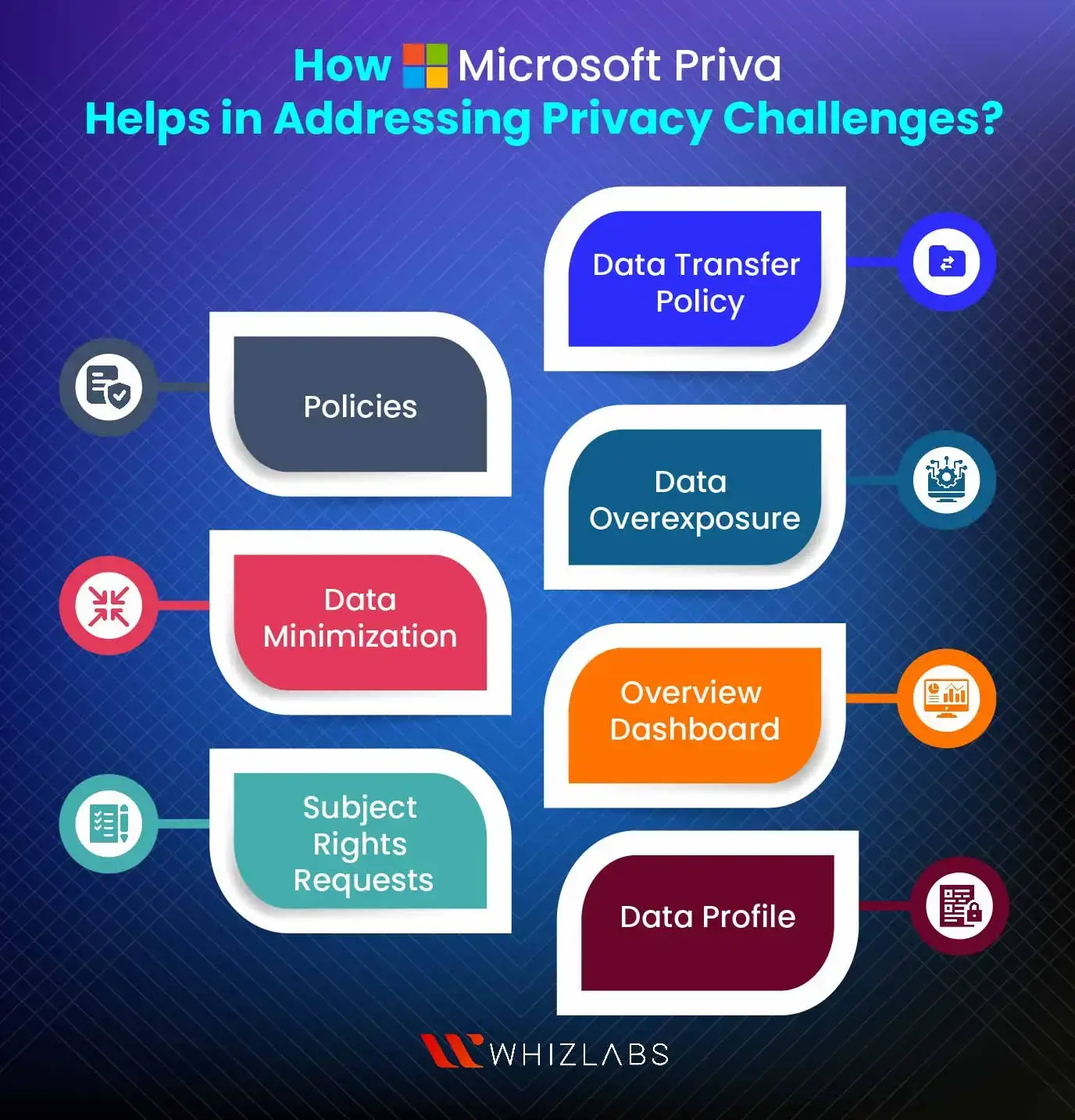In the digital age, a lot of personal information is stored online. This is a big worry for both people and businesses because they have to follow rules about privacy.
Certain laws like the European Union’s General Data Protection Regulation GDPR compliance and the California Consumer Privacy Act CCPA requirements don’t just apply in one place – they affect how companies everywhere keep personal data. These laws also give people the power to control how their data is gathered.
Just like we care about cybersecurity and being cautious even when there’s a breach risk, it’s smart to be careful about privacy too. This means making sure privacy is built into everything from the start. Using Microsoft Priva is a way to keep up these high standards for privacy.
This blog talks about what is Microsoft Priva, its capabilities, and how it helps to preserve privacy in a detailed manner.
Let’s dig in!
If you want to clear the SC-100 certification, then enriching your knowledge in Microsoft Priva can help you out.
What is Microsoft Priva?
Microsoft Priva is one of the features introduced in the Microsoft Compliance Centre for data privacy compliance.
Companies are dealing with a lot of messy data that keeps growing. It’s so much that people can’t keep up. Figuring out which data is private and understanding the risks of personal data that companies store and share is just the beginning.
Employees need to be trained to handle data properly and to find problems in how things are done now. They also need to respond quickly to requests for data. But with so much data, doing things by hand is slow and can lead to mistakes. Microsoft Priva helps with this. It makes data privacy easier to manage.
Why Privacy is important?
Changes in regulations concerning the collection and utilization of personal data by businesses have been significant throughout 2021. According to a Gartner report, these regulations will continue evolving into 2023. This will lead to multiple privacy laws that organizations need to decipher to ensure and demonstrate compliance.
Businesses are required to classify their data on a large scale, addressing several key questions:
- What kinds of personal data are in your records (like PII, PHI, PCI)?
- Where is this data located?
- What level of personal security is necessary?
- Who can access it?
- How will the data be employed?
- Do you have permission to use this data?
This challenge is especially pronounced for companies operating in North America. A significant number of states have either enacted or proposed legislation, which collectively encompasses over 85% of the U.S. population.
While regulations are expanding in a fragmented manner, many companies still rely on very traditional methods to manage privacy requirements. In terms of privacy risk management for unstructured data, the focus typically includes:
- Concentrating on locating personal data for record-keeping purposes.
- Depending largely on end users to identify personal data and demonstrate adherence to privacy rules.
- Heavily relying on surveys and task assignments to compile one-time inventories or fulfill data subject requests.
To earn and uphold the trust of customers and employees, and to conform to privacy regulations without impeding efficiency, organizations will need to make privacy an integral part of their business operations.
Also Read : Preparation Guide on SC-100:Microsoft Cybersecurity Architect
How Microsoft Priva help in Addressing Privacy Challenges?
Microsoft Priva is found in the Microsoft 365 compliance center and offers various ways to deal with this challenge:
- Policies: With Microsoft Priva, you can set up three types of privacy risk management rules. These rules can use ready-made templates for different types of sensitive information, like credit card data or addresses, which are made to follow specific privacy laws like GDPR and CCPA. You can also create your own rules to make sure you cover what you need. These rules help with:
- Data transfer Policy: This rule spots when personal data goes from one place to another, like from one department to another. It suggests what to do to keep that data safe, and you can change it to fit where the data is and what kind of data it is.
- Data minimization: This rule finds personal data that isn’t being used and doesn’t have any labels to say how long it should be kept.
- Data overexposure: This rule catches risks when personal data is shared too much, with people who shouldn’t see it, or when it’s not being used.
- Overview Dashboard: The dashboard gives you a clear look at trends and useful information about personal data, privacy rules when the rules are followed or broken, and requests from people about their data. You can see the different types of personal data, where it’s kept (like in email or shared files), and where it’s located in.
- Data Profile: This tool helps Privacy administrators check data that fits the rules. It lets them review matched content, where it’s saved, and who has access to it. This works like a tool you might already know called Content Explorer.
- Subject Rights Requests: Privacy Management makes it easier to answer requests from people about their data. It finds their data in Microsoft 365, even when there are other rules like legal holds. It also lets you add notes and hide some parts of the data if needed.
Capabilities of Microsoft Priva
The service offered by Microsoft Priva has been categorized into two major solutions such as:
- Priva Privacy Risk Management – It is a template-based solution that contains sensitive data to frame the privacy risk management policies to find and resolve the privacy risks which include transfer of data, exposure of information, training data handling workers to work smartly, and data minimization methods.
- Priva Subject Rights – It simplifies and automates the process of handling data access requests from individuals and managing the related case workflows.
Priva Privacy Risk Management
This aspect of Priva strengthens privacy and lowers risks associated with unprotected information by bringing visibility to an organization’s data and policies. Administrators now have a far better understanding of how personal data is stored and moved inside their company due to this solution. They can also understand any problems with their data streams and trends through key analytics and insights.
You can identify privacy concerns using the tools of privacy risk management, and you can set up procedures and policies for addressing them. Users are explicitly informed of problems and specified advice on how to solve them. They are now better equipped to manage risk mitigation with better assurance and precision.
It empowers them to address privacy problems they might not have been aware of such as personal data being shared too much, data that doesn’t need to be kept, or when data moves between different parts of the company or to other places. You can create your own rules to handle these situations.
Once you’ve set up your rules, the system will keep checking the data regularly. If there are any issues, it will let you know through alerts and suggest how to fix them.
Priva Subject Rights
This offers more support on the operational side of things. It uses automation and tools to handle data requests. This saves employees time and prevents mistakes. When privacy laws let people ask to see or control the personal data that companies have, those requests have to be met. But with lots of unorganized data, finding and giving the right information can take a long time.
Priva Subject Rights Requests have adaptable steps that can make this process automatic. A simple search for someone’s information will gather the data let you see it and make reports much faster. These steps also allow colleagues to work together and finish these tasks more efficiently.
FAQs
What are the capabilities and benefits of Microsoft Priva?
Priva offers tools that let you spot and safeguard against privacy dangers like collecting too much data, risky data transfers, and sharing more data than needed. Get a clear view of where personal data is stored and how it moves.
What are Microsoft Priva Subject Rights Requests?
The Microsoft Priva Subject Rights Requests solution aims to simplify and reduce the time required to address data subject inquiries, easing the complexity involved.
What advantages does Microsoft Purview offer?
Microsoft Purview delivers a cohesive data governance solution for overseeing and controlling your data across on-premises, multi-cloud, and software-as-a-service (SaaS) platforms. Effortlessly generate a complete and current overview of your data environment through automated data detection, labeling sensitive information, and tracing data lineage from start to finish.
Conclusion
Hope this article wraps up everything about Microsoft Priva, the challenges overcome by Microsoft Priva, its features, and why privacy is important.
Preserving data privacy is much required for the reputational firm and thus going for Microsoft Priva can help you out. To experience the real-time settings with Microsoft Priva, just explore our hands-on labs and sandboxes.
If you have any questions about this blog post, feel free to comment to us!
- Top 25 AWS Data Engineer Interview Questions and Answers - May 11, 2024
- What is Azure Synapse Analytics? - April 26, 2024
- AZ-900: Azure Fundamentals Certification Exam Updates - April 26, 2024
- Exam Tips for AWS Data Engineer Associate Certification - April 19, 2024
- Maximizing Cloud Security with AWS Identity and Access Management - April 18, 2024
- A Deep Dive into Google Cloud Database Options - April 16, 2024
- GCP Cloud Engineer vs GCP Cloud Architect: What’s the Difference? - March 22, 2024
- 7 Ways to Double Your Cloud Solutions Architect Role Salary in 12 Months - March 7, 2024




